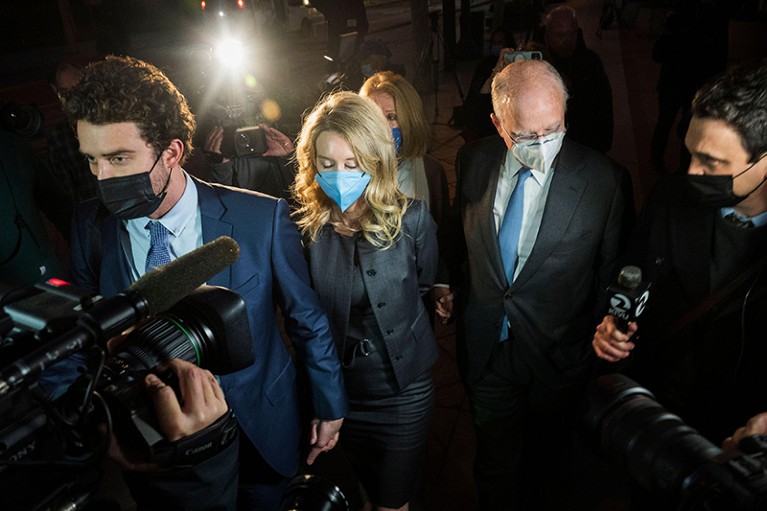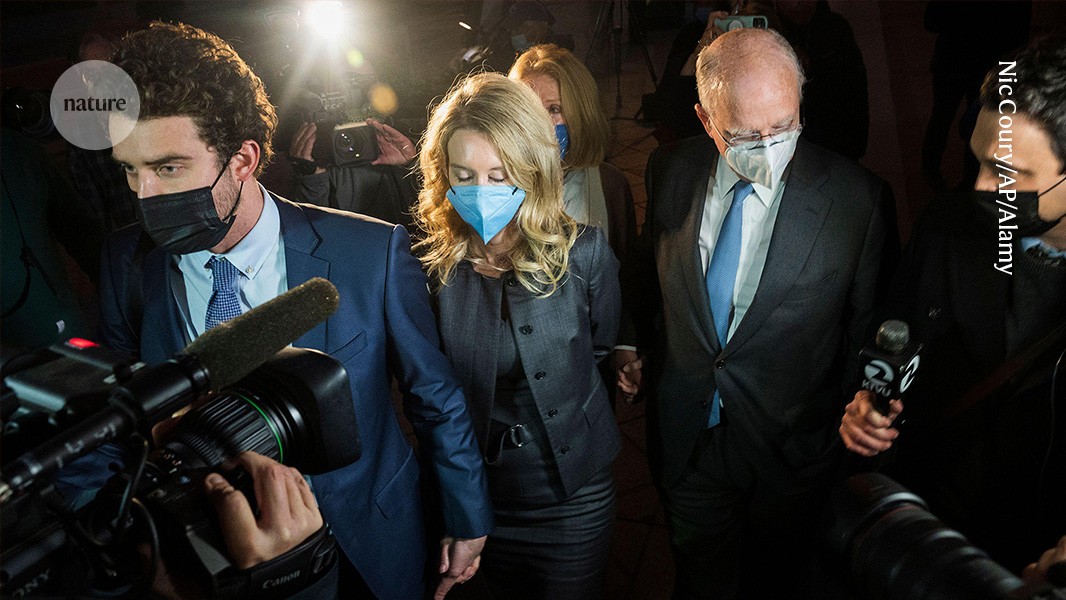
Elizabeth Holmes (second from left) was convicted of conspiracy and defrauding investors in her company, Theranos, after overhyping the science behind her work.Credit: Nic Coury/AP/Alamy
Sharing scientific discoveries requires as much care as uncovering them, a fact I didn’t fully appreciate until I moved from academia to public relations. Missteps in communication — whether intentional or not — can undermine trust and even harm the reputation of entire fields.
I started working in science communication as a postdoctoral fellow at the US National Institutes of Health (NIH), and I spent time in the policy and communications office at the NIH’s National Institute of Nursing Research. When the COVID-19 pandemic shut down non-urgent research on the NIH campus, I decided to start exploring careers in communication. I took a position supporting medical and scientific communications for the Congressionally Directed Medical Research Programs, which funds US biomedical research. In 2021, I transitioned into public relations through an account role at an agency called LifeSci Communications, in New York City; a year later, I shifted to specialize in scientific storytelling at Syneos Health Communications, also in New York.
In public relations, we shape how people perceive a company or a product, working across many communication platforms: websites, press releases, social media and more. In my role, I focus on creating a compelling narrative to help biotechnology and pharmaceutical companies communicate their scientific approach to investors, the media and consumers. For me, distilling complex topics into messages that resonate is a welcome challenge.
Whether helping a client to explain why the science behind their treatment is unique, or combating vaccine misinformation, I’ve found that the temptation to misrepresent, inflate or otherwise hype data is ever present, as are the dangers that come with doing so.
Consider Theranos, the biotech start-up in Palo Alto, California. The company’s bold claims about revolutionizing blood testing captured public and investor interest, but its refusal to acknowledge technical limitations or share transparent data led to one of the most notorious scandals in science and technology. Ultimately, the company was shut down in 2018, and founder Elizabeth Holmes was convicted of fraud in 2022.
‘Blood, sweat and tears’: Building a network for Black scientists
The fallout left scientists questioning whether the benefits of other scientific innovations had been over-inflated, and many called for more rigorous peer-reviewed evidence before funding new ventures. This ripple effect shows the stakes of miscommunication – it can undermine public trust in legitimate breakthroughs, spinning fact into fiction.
The temptation to ‘sell out’ is present across the science-communications industry, in which the pressure to stand out might overshadow the responsibility to communicate with integrity. Overselling findings, cherry-picking data or making claims that the evidence does not yet support can seem like a quick route to funding or to recognition. But these shortcuts come at a cost: eroded trust, scepticism about future work and, in some cases, damage to a field’s reputation.

Kisha Greer works in public relations, helping companies to honestly and ethically communicate their scientific approach.Credit: Julia Johnson Photography
The lessons from Theranos are clear: hype and secrecy are a dangerous combination. But how can scientists avoid these pitfalls and communicate their work responsibly? Here are some strategies for selling science without crossing the line into spin.
Set realistic expectations
Science is inherently exciting; it offers new possibilities and solutions to pressing challenges. But that excitement should never come at the expense of honesty. Research is rarely foolproof, and overselling it by exaggerating its impact or downplaying its limitations can backfire, leading to disappointment and scepticism when the full picture emerges.
One way to set realistic expectations is to ask yourself, “If this statement was taken out of context in a headline, would it still accurately represent the research?” This exercise helps to identify overly broad or optimistic phrases, which should be replaced with precise, contextual language such as ‘early-stage research’ or ‘preclinical findings’.
Another approach is to emphasize the scientific journey rather than just the destination. Instead of saying, “On the basis of the early clinical data, this treatment could cure cancer,” highlight the next step forwards: “Early clinical data suggest this treatment has the potential to improve outcomes for people with cancer. To explore this further, we’ve initiated a phase II study to better understand its effects and expect to see initial results by the end of the next year.” This statement highlights progress while acknowledging that the research is ongoing.
Clear communication ensures that audiences understand the iterative nature of science. Research evolves. Setting realistic expectations from the start fosters trust and enthusiasm that will last beyond the initial headlines.
Know your audience’s needs
A message that resonates with one group might fall flat with another. Tailoring communication to your audience is critical.
For instance, if you’re writing a grant application for research on stem-cell responses to traumatic brain injury (TBI), focus on feasibility, potential impact and measurable goals to show how the work could fill a gap in TBI treatments. When presenting your findings at a scientific conference, highlight the methodologies and technical details that underpin your results. Discuss, for example, which imaging techniques were used to track the integration of stem cells and the strategies for quantifying stem-cell responses.
If, instead, you are communicating to the general public, focus on why your research matters to society and what people can expect as a result. Avoid boring them with too many technical details. This might require simplifying your message, so that more people can understand it: “My research explores how the brain can heal itself by using its own cells to repair damage.”
By aligning your message with your audience’s needs, you can prevent misunderstandings and ensure that the most relevant information comes through. Clear, targeted messaging builds credibility, creating a foundation for long-term engagement.
Use data transparently to build trust
Transparency is more than an ethical responsibility; it’s the foundation of trust. People respect honesty, especially when it includes uncertainties and setbacks.
Data are at the core of science and should be used thoughtfully and generously to support your points. Highlighting only favourable results can give a skewed picture of the research, leading audiences to overestimate its impact. Instead, aim for a balanced view, showing both supportive and contrasting data and acknowledging any limitations.
When preparing to present data, I often start by asking, “What’s the most important takeaway, and what context does the audience need to fully understand it?” For example, if a study on Parkinson’s disease showed positive results in a small subgroup of participants with mild neurocognitive decline but mixed outcomes in the overall study group, craft your messaging to reflect that variability.
Emphasize how the findings added to the scientific understanding of the disease. Rather than focusing solely on the positive results found in the subgroup, this approach provides the context needed to position the study as an important step forwards without overstating its immediate implications for people with Parkinson’s.
Such transparency builds trust with your audience and amplifies the impact of your science.



